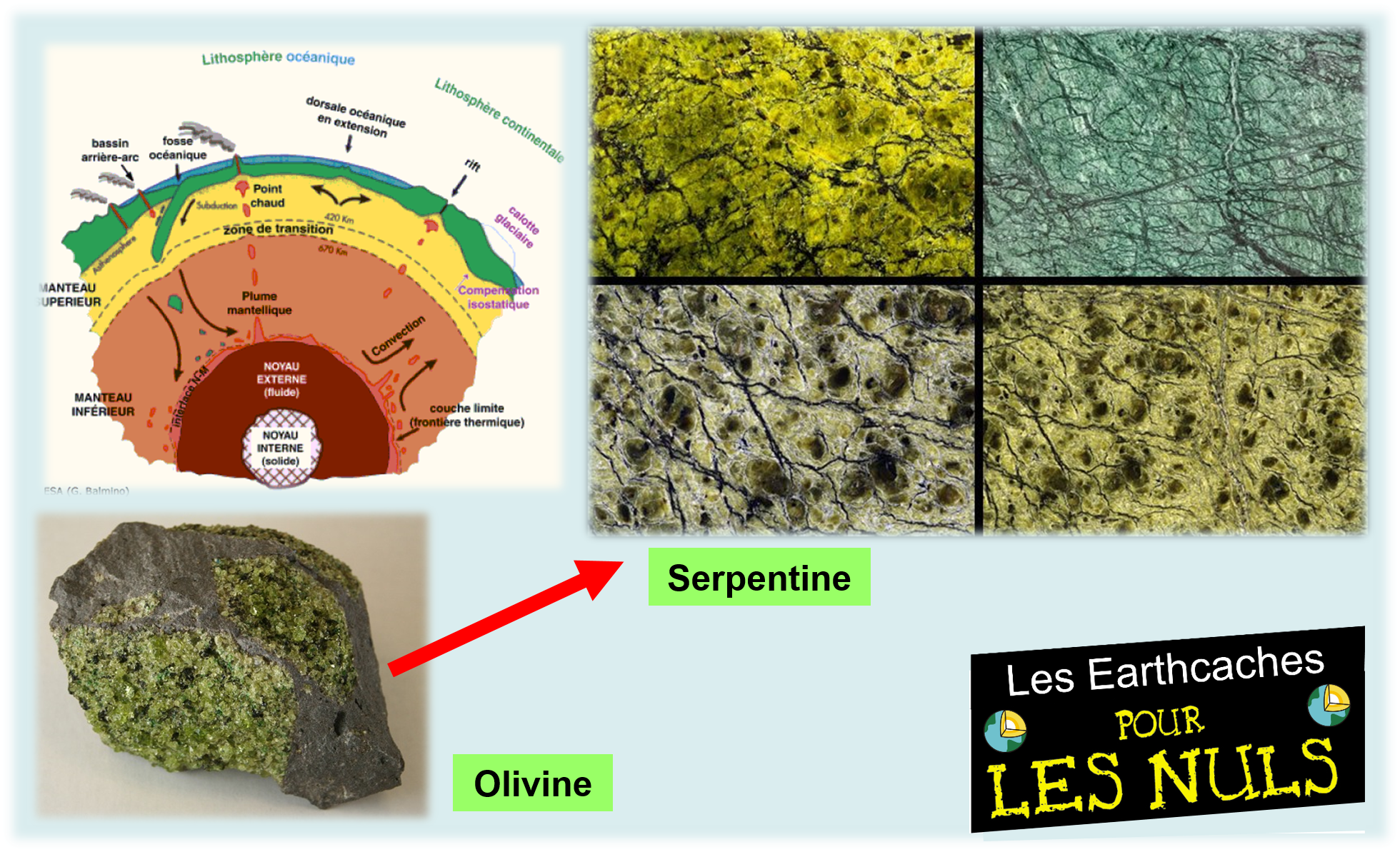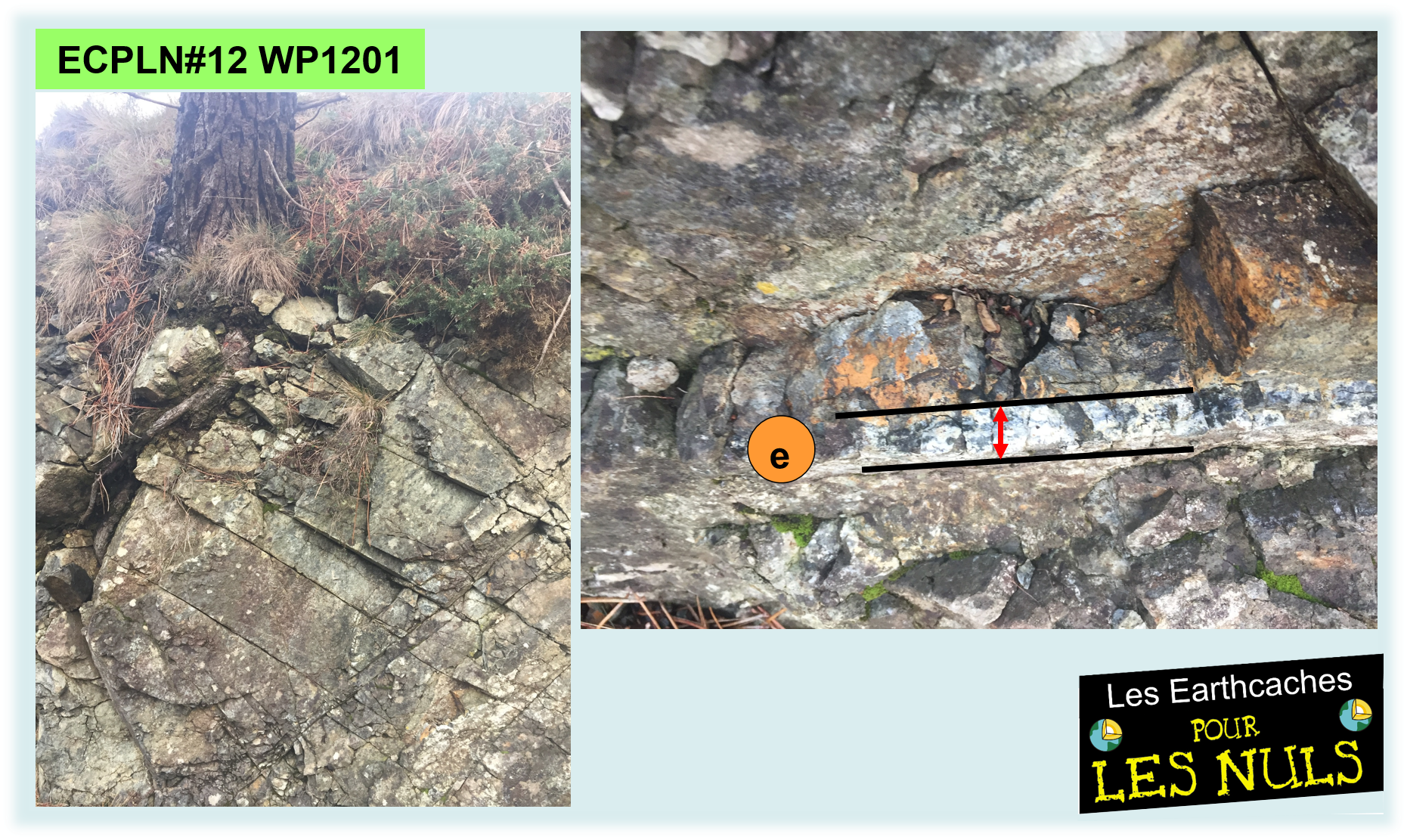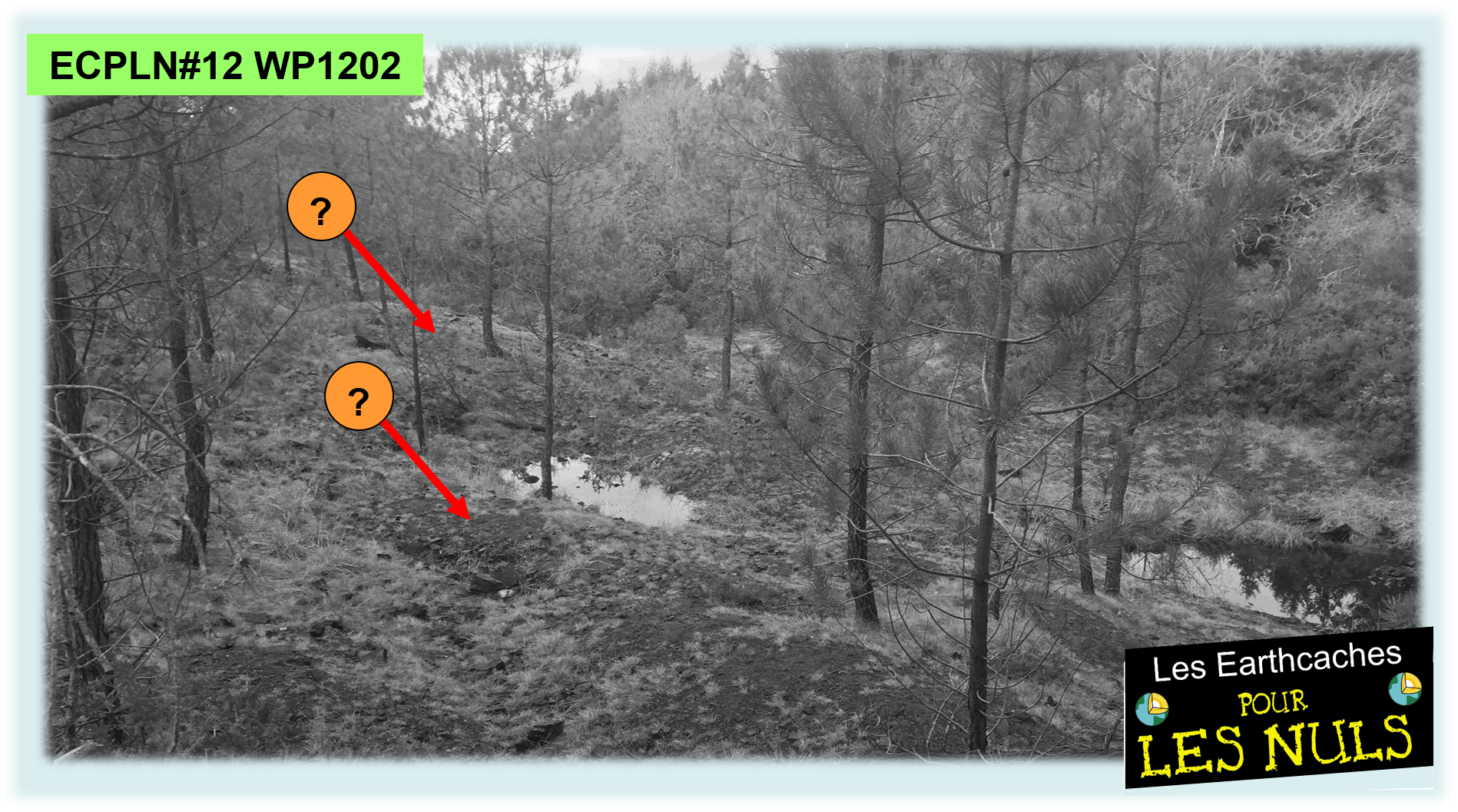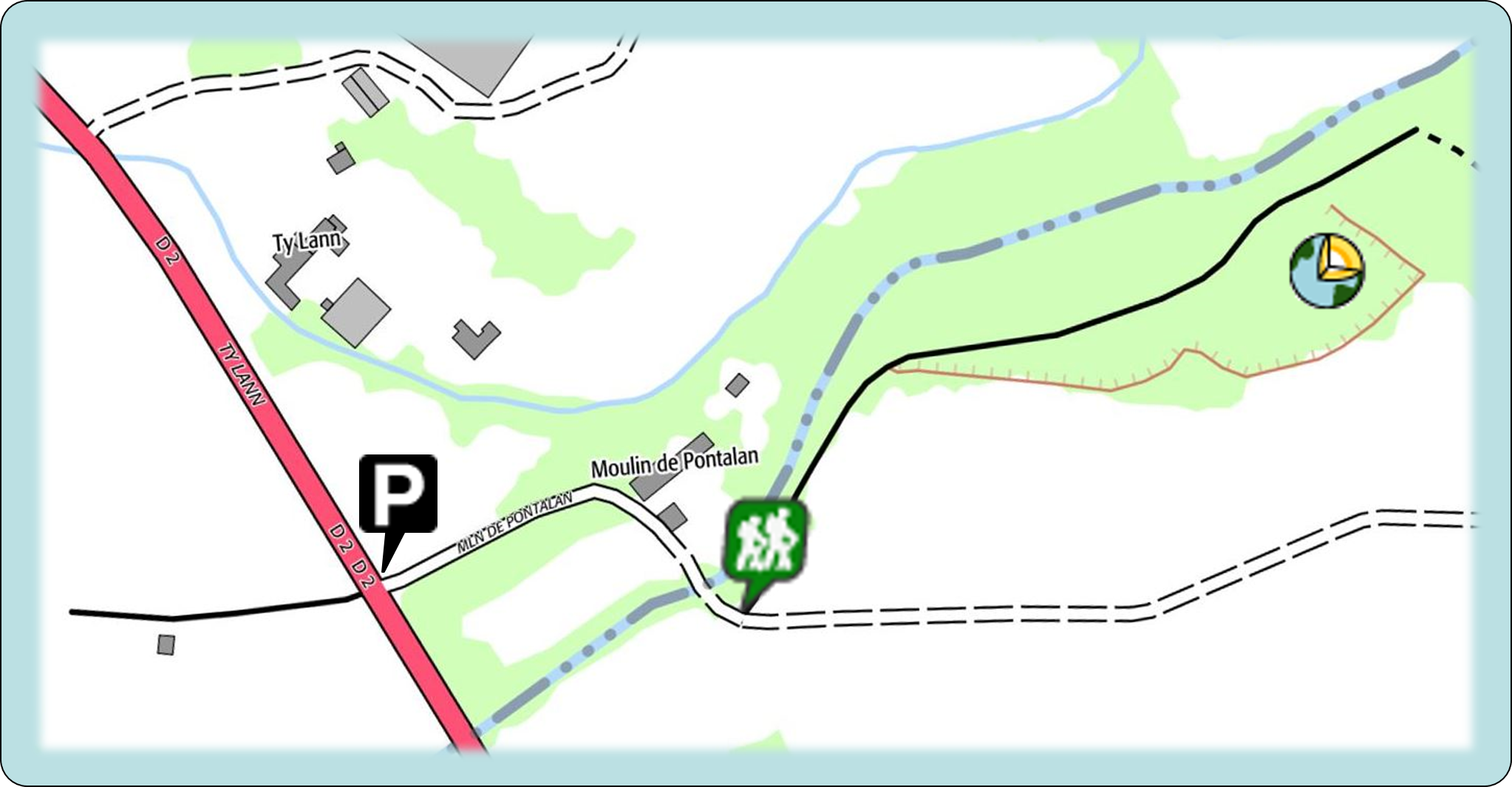Présentation / Presentation :
 Pour la douzième cache de cette nouvelle série… on va continuer à faire très simple : Ne cherchez pas de boîte, ou de conteneur, il n’y en a pas…
Pour la douzième cache de cette nouvelle série… on va continuer à faire très simple : Ne cherchez pas de boîte, ou de conteneur, il n’y en a pas…
Matériel à emporter: vos yeux, votre GPS, un mètre ruban, et le descriptif de cette earthcache.
 For the twelfth cache of this new series ... we will continue to do very simple: Do not look for box, or container, there is not ...
For the twelfth cache of this new series ... we will continue to do very simple: Do not look for box, or container, there is not ...
Takeaway material: your eyes, your GPS, a tape measure, and the descriptive of this earthcache.
 Rappel géologique :
Rappel géologique :
Voici comment est décrite la formation de cet affleurement, sur la notice de la carte géologique: "Serpentinites (métapéridotites). Sur cette feuille apparaît la partie occidentale du massif de serpentinites qui affleurent depuis Kerguelmé (Nord de Peumerit, feuille Quimper) jusqu'à Ty-Lan où elles s'étendent largement. / … / Ce sont des roches compactes et sombres, parfois rubanées par la présence de lits centimétriques vert clair. Dans les faciès massifs, le minéral essentiel est l'antigorite à structure maillée accompagnée de restes de cristaux d'olivine, de pyroxène et d'amphibole incolore. La magnétite est abondante, le pyroxène est très altéré, la trémolite le recoupant nettement; le grenat est rare et chloritisé; de rares plages de séricite, zoïsite, calcite permettent de soupçonner la présence antérieure d'un plagioclase basique. Le rubanement de certains faciès est dû à la concentration de trémolite en lits de faible épaisseur."
Pfff … pas facile facile à lire tout ça !!! Voyons un peu avec quelques définitions simples:
Serpentine: minéral: silicate de magnésium. Si elle est en lamelles, c’est de l’antigorite, si elle est en fibres, c’est du chrysotile.
Serpentinisation: transformation chimique de minéraux ferro-magnésiens (olivine et/ou pyroxènes). La réaction type est: olivine + eau ---> serpentine + brucite.
Serpentinite: roche dérivant, par altération et/ou métamorphisme, de roches magmatiques basiques ou ultrabasiques (comme les péridotites, roches mantellaires). Cette roche est composée en presque totalité de chrysotile et/ou d’antigorite, accompagnés d’oxydes de fer. Roche assez tendre, verte, avec des tons variés, sombres et clairs irrégulièrement.
Brucite: minéral, hydroxyde de magnésium, fibreux, blanc à verdâtre.
Olivine: minéral, silicate de magnésium et de fer. Principal constituant des péridotites, roche du manteau terrestre, formée à plusieurs dizaines de km de profondeur, lors de collisions de plaques tectoniques (durant l‘orogénèse hercynienne).

 Geological reminder:
Geological reminder:
Here, we describe the formation of this outcrop on the record of the geological map: "Serpentinites (metaperittites)." On this sheet appears the western part of the massif of serpentinites which have been exposed since Kerguelmé (north of Peumerit, leaf Quimper) Ty-Lan where they extend widely ... / / These are compact and dark rocks, sometimes banded by the presence of light green centimeter beds .. In the massive facies, the essential mineral is the antigorite with mesh structure accompanied by remains Crystals of olivine, pyroxene and colorless amphibole Magnetite is abundant, pyroxene is very altered, tremolite clearly intersects it, garnet is rare and chloritised, rare ranges of sericite, zoïsite and calcite make it possible to suspect The presence of a basic plagioclase, and the bandage of certain facies is due to the concentration of tremolite in thin beds.
Pfff ... not easy easy to read all that !!! Let's look a little with some simple definitions:
Serpentine: mineral: magnesium silicate. If it is in strips, it is antigorite, if it is in fibers, it is chrysotile.
Serpentinization: chemical transformation of ferro-magnesian minerals (olivine and / or pyroxenes). The typical reaction is: olivine + serpentine ---> water + brucite.
Serpentinite: rock derived, by alteration and / or metamorphism, from basic or ultrabasic magmatic rocks (such as peridotites, mantellar rocks). This rock is composed almost entirely of chrysotile and / or antigorite, accompanied by oxides of iron. Rock fairly tender, green, with varied tones, dark and irregularly clear.
Brucite: mineral, magnesium hydroxide, fibrous, white to greenish.
Olivine: mineral, magnesium silicate and iron. The principal constituent of peridotites, the rock of the Earth's mantle, formed several tens of kilometers deep, during collisions of tectonic plates (during the Hercynian orogeny).
 Observons :
Observons :
Votre mission sera d‘observer, de bien lire, de comprendre, de mesurer, et, bien sûr, de répondre aux questions.
 Observe:
Observe:
Your mission will be to observe, read well, understand, measure, and, of course, answer questions.
Pour loguer cette cache / To log this cache :


 Pour valider votre visite sur le site, envoyez-moi, en précisant bien le nom de l’earthcache, vos réponses par courrier électronique (à partir de mon profil, ou sur la messagerie [Message Center] de geocaching.com) aux questions suivantes. Vous pouvez loguer "Found it", je vous contacterai en cas de nécessité:
Pour valider votre visite sur le site, envoyez-moi, en précisant bien le nom de l’earthcache, vos réponses par courrier électronique (à partir de mon profil, ou sur la messagerie [Message Center] de geocaching.com) aux questions suivantes. Vous pouvez loguer "Found it", je vous contacterai en cas de nécessité:
WP1201: Q1: Regardez vers l’arbre, puis penchez-vous pour retrouver le filon, et mesurez son épaisseur e=__ ?
WP1201: Q2: Retournez-vous, et rendez-vous au niveau des deux flêches indiquées. Quelle est la couleur dominante de la roche massive à vos pieds ?
WP1201: Q3: A quel constituant chimique pouvez-vous associer cette couleur ? Quel minéral cité en contient ?
Une photo du site, en noir et blanc, sera la bienvenue, bien que facultative.
 To validate your visit to the site, send me, although specifying the name of the earthcache, your answers by e-mail (from my profile, or email [Message Center] from geocaching.com) the following questions . You can log "Found it," I will contact you if necessary:
To validate your visit to the site, send me, although specifying the name of the earthcache, your answers by e-mail (from my profile, or email [Message Center] from geocaching.com) the following questions . You can log "Found it," I will contact you if necessary:
WP1201: Q1: Look towards the tree, then lean to find the vein, and measure its thickness e = __?
WP1201: Q2: Turn around, and go to the two indicated arrows. What is the dominant color of the massive rock at your feet?
WP1201: Q3: To which chemical constituent can you associate this color? What mineral does it contain?
A picture of the site, in black and white, will be welcome, but voluntary.
Sources / Sources :
Documentation « papier » : Notice de la carte géologique de la France au 50000ème, Dictionnaire de géologie Masson, Série des Guides géologiques régionaux Masson, Curiosités Géologiques du Pays bigouden, éditions Apogée.
Consultations sur Internet: http://infoterre.brgm.fr/ ; Google Earth ; Geowiki ; Wikipedia ;
 Rappel concernant les « Earthcaches »: Il n'y a pas de conteneur à rechercher ni de logbook à renseigner. Il suffit de se rendre sur les lieux, de bien lire le descriptif, d’observer et de comprendre pour pouvoir répondre aux questions ci-dessus. Loguez „Found it „ et, en même temps, envoyez nous vos propositions de réponses via notre profil, soit par mail, soit par la messagerie (message center). En cas de problème, nous vous contacterons. Merci de ne pas faire figurer de réponse dans vos logs !
Rappel concernant les « Earthcaches »: Il n'y a pas de conteneur à rechercher ni de logbook à renseigner. Il suffit de se rendre sur les lieux, de bien lire le descriptif, d’observer et de comprendre pour pouvoir répondre aux questions ci-dessus. Loguez „Found it „ et, en même temps, envoyez nous vos propositions de réponses via notre profil, soit par mail, soit par la messagerie (message center). En cas de problème, nous vous contacterons. Merci de ne pas faire figurer de réponse dans vos logs !
 Reminder concerning "Earthcaches" There is no container to search for information or logbook. Simply visit the site, to read the description, observe and understand in order to answer the questions above. Log in "Found it" and at the same time, send your answers via our profile proposals, either by email or by mail (Message Center). In case of problem, we will contact you. Thank you not to include response in your logs!
Reminder concerning "Earthcaches" There is no container to search for information or logbook. Simply visit the site, to read the description, observe and understand in order to answer the questions above. Log in "Found it" and at the same time, send your answers via our profile proposals, either by email or by mail (Message Center). In case of problem, we will contact you. Thank you not to include response in your logs!

